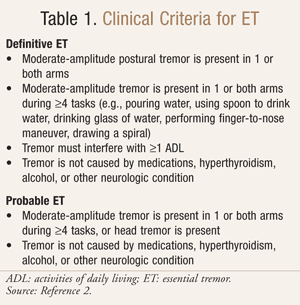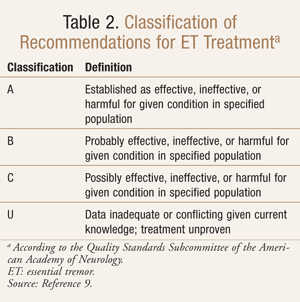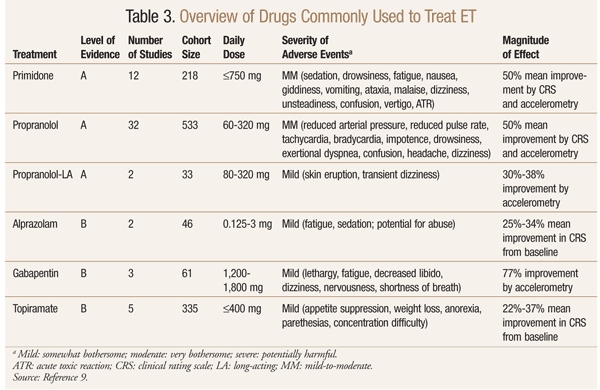US Pharm. 2011;36(3):HS-23-HS-27.
Essential tremor (ET) is an involuntary movement disorder of unknown cause that lacks a specific set of diagnostic criteria. In addition, pharmacologic treatment is modest, with only one FDA-approved drug and one off-label agent. This condition was believed to be benign, nothing more than a disruption of daily activities and a source of embarrassment. However, recent studies have demonstrated the evolution of ET in many areas. This review discusses the causes, prevalence, diagnosis, and current pharmacologic treatment of ET. In addition, some lifestyle modifications for ET are discussed.
Epidemiology
ET, one of the most common movement disorders, is more prevalent than Parkinson’s disease, affecting between 0.4% and 6% of the population worldwide.1-3 It is believed that ET affects 5 to 10 million people in the United States.4 ET has been shown to have a bimodal incidence peak; it usually develops in either one’s teens or one’s 60s, with prevalence increasing with age, especially past 65 years.1,2
Etiology
The precise etiology and pathophysiology of ET are unknown. Many studies indicate a hereditary linkage. Approximately 50% to 60% of ET patients have a first-degree relative with ET.1,3 ET, often referred to as familiar tremor, is believed to be inherited via an autosomal-dominant gene. Although the exact gene has yet to be discovered, some studies have found loci of specific interest.4-6 One theory holds that early-onset ET is more commonly tied to the hereditary form of ET, as opposed to nongenetic ET.3 Based on clinical observation, it is believed that the cerebellum or the cerebellothalamocortical pathway is the center of origin or site of involvement.4,5 However, disagreement exists as to whether ET is a specific disease or a manifestation of symptoms of various causes.7
Clinical Characteristics
ET is progressive with multiple characteristics. Two different kinds of tremors may occur. The main type (postural tremor) presents when a person tries to maintain posture, such as by elevating the arms or sitting upright.1,2 The second type (kinetic or intention tremor) occurs when a person tries to perform an action such as touching the nose with the index finger or pouring a glass of water.1,2,5 Tremors are seen in the hands and upper limbs in 90% to 95% of patients. The head is involved 30% of the time, the voice 20% of the time, and the lower limbs and face or jaw 10% of the time.1-3 The tremor has a high frequency (4-12 Hz). In addition to frequency, ET can be measured by amplitude (the maximum extent of tremor oscillation).1-3
ET has not been linked to any comorbid disease states. In recent years, the term benign has become outdated, since studies have found nonmotor symptoms with progression of ET. These symptoms include cognitive changes, depression, social phobias, anxiety, and hearing and smelling defects.3,5 Additionally, some patients have impaired gait, which supports the belief that ET originates in the cerebellum.5
Diagnosis
There are currently no laboratory tests or scans for diagnosing ET. It is essential to take a thorough medical and family history in patients presenting with ET. Because of the variability in clinical diagnosis, ET is confused with other diseases or disorders and is misdiagnosed 30% to 50% of the time.3 A complete medication review should be performed, since many different drugs have been implicated in ET.2 Common agents include steroids, beta agonists, selective serotonin reuptake inhibitors, levothyroxine, lithium, and valproate. These agents, along with caffeine, cigarettes, and certain disease states (e.g., hyperthyroidism, Parkinson’s disease, dystonia, Wilson’s disease), are among the numerous possible causes of ET.2
The diagnosis of ET can be confusing and somewhat difficult at times. At present, there is no gold standard for diagnosis, but there are some common clinical criteria that are generally agreed upon by many physicians. Four of these criteria are considered definitive for ET; two others are deemed probable for ET (TABLE 1).2

Although family history and responsiveness to propranolol commonly occur in ET, these are not necessary for diagnosis.8 Interestingly, a majority of ET patients experience tremor reduction and gait improvement with alcohol use, but this also is not considered necessary for diagnosis.7,8
Treatment
Questions remain about the best pharmacologic treatment for ET. Currently, there are two first-line agents, propranolol and primidone, only one of which is FDA approved for this indication.9 Approximately 25% to 55% of patients taking these agents do not experience a response.2 Beta-blockers other than propranolol also have been used to treat ET, but as a class they may be dangerous in elderly patients because of many drug–disease and drug–drug interactions.
Since current therapy for ET is not only limited but often unsuccessful and inconvenient, many different drugs and drug classes have been tried as possible treatments. Some second-line agents, such as anticonvulsants and short-acting benzodiazepines, have shown mediocre efficacy.9 In 2005, the Quality Standards Subcommittee (QSS) of the American Academy of Neurology issued recommendations for the treatment of ET. The QSS uses a rating system consisting of levels A, B, C, and U (TABLE 2).9 See TABLE 3 for a breakdown of the more common agents used to treat ET.9


Propranolol: Propranolol is the only drug approved by the FDA for ET. It is a nonselective beta-blocker that has shown tremor reduction of up to 50%.9,10 Propranolol is useful in reduction of tremor amplitude, but not frequency. Across all therapies, complete suppression of ET is rare. Propranolol appears to work best in high-amplitude, low-frequency ET.10 Therapeutic doses seem to be patient-specific, and patient response is variable. Therefore, many different doses show therapeutic reduction in tremors. Doses from 60 mg to 320 mg per day have been shown to be effective. Some patients experience tremor reduction only at doses exceeding 120 mg daily.2,9,10 In most cases, propranolol is used for daily maintenance and suppression of ET. It also may be used as needed to prevent or treat exacerbations during social situations or planned events.10
Another option is long-acting propranolol (propranolol-LA). Once-daily dosing of propranolol-LA has been shown to be as effective as regular propranolol.9,11 As in most situations, once-daily dosing vastly improves patient adherence owing to convenience and reduction in the number of tablets the patient must take. The adverse events (AEs) occurring with propranolol therapy for ET are similar to those experienced when it is used for other disease states. Both propranolol and propranolol-LA are recommended by the QSS as first-line therapy for ET (level A).9 The most common AEs (12%-66% of patients) are bradycardia, lightheadedness, fatigue, headache, and impotence.
Primidone: Primidone, the other first-line agent, is an anticonvulsant that has been found effective for treating ET. This is currently an off-label indication. Primidone is metabolized into phenylethylmalonamide and phenobarbitone. There is some controversy as to whether the parent compound or the barbiturate metabolite is responsible for the positive effect.2 In a head-to-head trial with propranolol, primidone was shown to be equally effective for reducing ET. One major drawback of primidone is the possibility of an acute toxic reaction that can present at therapy initiation, resulting in nausea, vomiting, ataxia, sedation, and giddiness even when the dose is slowly titrated.12
Although primidone’s initial tolerability is weak, some studies have found its long-term tolerability to be greater than that for propranolol, and patients selected primidone as more desirable.2,13 Doses ranging from 50 mg to 1,000 mg daily have been found to be effective.2 Primidone has not been found superior to propranolol; however, it is an alternative for patients who are intolerant to or uncontrolled on propranolol, or for those in whom propranolol is contraindicated. Primidone has been recommended as first-line therapy (level A) by the QSS.9 In some studies, the combination of primidone and propranolol has been beneficial for head tremor where neither agent alone was effective, and the combination yielded a slight improvement in tremor reduction versus monotherapy.9,12
Gabapentin: Gabapentin, an anticonvulsant structurally similar to gamma-aminobutyric acid, has been used to treat ET. Multiple studies have yielded mixed results for effectiveness. Doses ranging from 1,200 mg to 3,600 mg daily have been tried.2 In a comparative trial, gabapentin was as effective as propranolol for reducing ET.14 Another study found a modest effect compared with placebo, but suggested that gabapentin was beneficial as add-on therapy with either propranolol or primidone.15 Other studies have reported gabapentin to be ineffective as adjunctive therapy for ET.3,9,14 Overall, gabapentin is well tolerated; other than fatigue and somnolence, few AEs have been reported.14,15 The QSS gave gabapentin a level B recommendation.9
Topiramate: An anticonvulsant, topiramate is approved for epilepsy treatment and migraine prophylaxis. Multiple studies have shown a beneficial reduction in ET with doses of up to 400 mg a day.16-18 Topiramate has been shown to be effective, but has not been compared with either propranolol or primidone. In one study, results of topiramate therapy were compared with those of propranolol therapy in a related trial, with similar reductions reported.18 Although topiramate shows some promise for treating ET, the high incidence of AEs such as weight loss, paresthesias, and concentration difficulty, as well as the lack of demonstrated superiority to propranolol or primidone, led the QSS to give topiramate a level B rating.9,16-18
Alprazolam: Alprazolam is a short-acting benzodiazepine with some efficacy in treating ET.3 Studies of doses ranging from 0.125 mg to 3 mg daily have yielded a 25% to 34% reduction in limb tremor.9 One study reported a mean effective daily dose of 0.75 mg.19 Although alprazolam has shown some efficacy for reducing ET, physicians tend to use it cautiously because of its abuse potential and increased number of AEs. In some studies, up to 50% of patients taking alprazolam experienced increased fatigue and sedation.2,9 The QSS recommends that alprazolam be used with caution owing to the possibility of dependence (level B).9
Other Treatment Options: Many different drugs have been used to treat ET. Anticonvulsants and antidepressants have been studied, along with other beta-blockers and some calcium channel blockers.9 Mirtazapine, an antidepressant with some antihistaminic effects, has been evaluated in two trials.20,21 These trials have had mixed results; one suggested that mirtazapine is an extremely helpful treatment, while in the other only one patient experienced benefit.20,21 Given the lack of adequate scientific studies and the variable results, the QSS does not recommend using mirtazapine for the treatment of ET (level C).9
Zonisamide, an anticonvulsant thought to have antitremor effects, has had mixed results.3,22 A small study found an improvement in patients who had previously tried other medications. The study’s small sample size and the large number of AE-related dropouts limit zonisamide’s use.22 Levetiracetam, another anticonvulsant, has failed to reduce limb tremors associated with ET.3,23 Some studies have found that injections of botulinum toxin type A in the hands and arms modestly reduced tremor. However, hand and muscle weakness occurred in 30% to 70% of patients.5,9,24
Clinical Trials
Over the past 5 to 10 years, many different drugs have been tested for their utility in treating ET. This effort will most likely continue based on the mixed results and poor success seen thus far.
Currently, nearly 30 clinical trials are being conducted.25 One drug under consideration is carisbamate, which is in a phase II trial. Another drug of interest is pregabalin (Lyrica), a miscellaneous anticonvulsant and analgesic used as adjunctive therapy in partial seizure disorders and for diabetic neuropathy and fibromyalgia. Several trials of pregabalin are being performed, one of them at phase IV. While ethanol is considered one of the most effective treatments for ET, its AEs and addictive potential make it an impractical long-term treatment.26 Octanoic acid (8-carbon straight-chain fatty acid) and 1-octanol (octyl alcohol) are drawing the most interest for treating alcohol-responsive ET. Multiple clinical trials of 1-octanol for ET therapy are being performed.26
Pharmacist Intervention
Not all patients with ET need to be treated pharmacologically. For patients who do not need or want to start medications, there are a few simple lifestyle modifications and counseling points the pharmacist can emhasize. For example, ETs tend to lessen with rest, so the pharmacist should discuss proper sleep hygiene, such as reserving the bedroom for sleep only. Avoidance of caffeine, food, or television viewing close to bedtime may help patients obtain restful sleep.
Alcohol may reduce ET in certain patient populations.1-3 (The pharmacist must tread carefully here, given the dangers alcohol consumption poses.) If mentioning this finding to a patient, the pharmacist must emphasize moderation. Although the amount of alcohol needed to reduce tremor is not specific, moderation typically means no more than one or two drinks per day.
Patients tend to forget that avoiding certain substances or situations can help with tremor reduction. It may be helpful to counsel patients to avoid cigarettes and caffeine and to reduce stress. Light exercise (e.g., walking or yoga) may be recommended to help patients relieve stress.
Conclusion
A common movement disorder, ET is characterized by postural and kinetic tremors and, in some cases, impaired walking, along with some nonmotor symptoms. Many ET patients have family members who have been diagnosed with ET, pointing to a strong hereditary link that has yet to be thoroughly documented.
Without a gold standard for diagnosis, confusion exists as to an exact definition and, therefore, the prevalence of the disorder. For now, gaps in pharmacologic treatment remain. Currently, propranolol and primidone are the only two agents that show an equivalent benefit. Many other medications have been used and will continue to be evaluated in an effort to develop better treatment with fewer AEs. However, more studies are needed in the areas of etiology, genetics, and potential treatment of ET.
REFERENCES
1. Cubo E, Christopher G. Essential tremor. In: Aminoff M, Daroff R, eds. Encyclopedia of the Neurological Sciences. San Diego, CA: Academic Press; 2003:301-302.
2. Louis E. Essential tremor. N Engl J Med. 2001;345:887-891.
3. Zesiewicz T, Chari A, Jahan I, et al. Overview of essential tremor. Neuropsychiatr Dis Treat.
4. Olanow CW. Hyperkinetic movement disorders. In: Fauci AS, Braunwald E, Kasper DL, et al, eds. Harrison’s Principles of Internal Medicine. 17th ed. New York, NY: McGraw-Hill Professional; 2008.
5. Elble R, Deuschl G. An update on essential tremor. Curr Neurol Neurosci Rep. 2009;9:273-277.
6. Deng H, Le W, Jankovic J. Genetics of essential tremor. Brain. 2007;130:1456-1464.
7. Jankovic J. Essential tremor: a heterogenous disorder. Mov Disord. 2002;17:638-644.
8. Klebe S, Stolze H, Grensing K, et al. Influence of alcohol on gait in patients with essential tremor. Neurology. 2005;65:96-101.
9. Zesiewicz TA, Elble R, Louis ED, et al. Practice parameter: therapies for essential tremor: report of the Quality Standards Subcommittee of the American Academy of Neurology. Neurology.
10. AHFS Drug Information. Propranolol hydrochloride. In: Lexi-Comp Online [subscription required].
www.lexi.com. Accessed October 15, 2010.
11. Cleeves L, Findley LJ. Propranolol and propranolol-LA in essential tremor: a double blind comparative study. J Neurol Neurosurg Psychiatry. 1988;51:379-384.
12. Findley LJ, Cleeves L, Calzetti S. Primidone in essential tremor of the hands and head: a double blind controlled clinical study. J Neurol Neurosurg Psychiatry. 1985;48:911-915.
13. Gorman WP, Cooper R, Pocock P, Campbell MJ. A comparison of primidone, propranolol, and placebo in essential tremor, using quantitative analysis. J Neurol Neurosurg Psychiatry. 1986;49:64-68.
14. Gironell A, Kulisevsky J, Barbanoj M, et al. A randomized placebo-controlled comparative trial of gabapentin and propranolol in essential tremor. Arch Neurol. 1999;56:475-480.
15. Ondo WG, Hunter C, Vuong KD, et al. Gabapentin for essential tremor: a multiple-dose, double-blind, placebo-controlled trial. Mov Disord. 2000;15:678-682.
16. Connor GS. A double-blind placebo-controlled trial of topiramate treatment for essential tremor. Neurology. 2002;59:132-134.
17. Ondo WG, Jankovic J, Connor GS, et al. Topiramate in essential tremor: a double-blind, placebo-controlled trial. Neurology. 2006;66:672-677.
18. Connor GS, Edwards K, Tarsy D. Topiramate in essential tremor: findings from double-blind, placebo-controlled, crossover trials. Clin Neuropharmacol. 2008;31:97-103.
19. Gunal DI, Afsar N, Bekiroglu N, Aktan S. New alternative agents in essential tremor therapy: double-blind placebo-controlled study of alprazolam and acetazolamide. Neurol Sci. 2000;21:315-317.
20. Uccellini D, Grampa G, La Spina I, et al. Mirtazapine in the treatment of essential tremor: an open-label, observer-blind study. Neuropsychiatr Dis Treat. 2006;2:95-100.
21. Pahwa R, Lyons KE. Mirtazapine in essential tremor: a double-blind, placebo-controlled pilot study. Mov Disord. 2003;18:584-587.
22. Ondo WG. Zonisamide for essential tremor. Clin Neuropharmacol. 2007;30:345-349.
23. Elble RJ, Lyons KE, Pahwa R. Levetiracetam is not effective for essential tremor. Clin Neuropharmacol. 2007;30:350-356.
24. Brin MF, Lyons KE, Doucette J, et al. A randomized, double masked, controlled trial of botulinum toxin type A in essential hand tremor. Neurology. 2001;56:1523-1528.
25. ClinicalTrials.gov. List results: essential tremor.
http://clinicaltrials.gov/ct2/ 2010;6:401-408. 2005;64:2008-2020.
26. Koller WC. A new drug for treatment of essential tremor? Time will tell. Mayo Clin Proc. 1991;66:1085-1087.
To comment on this article, contact rdavidson@uspharmacist.com.





